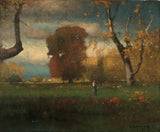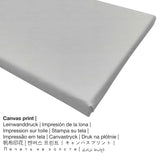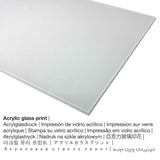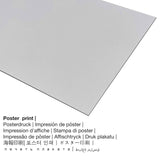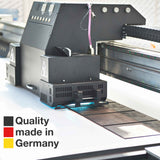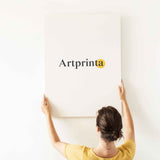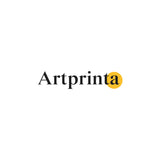George Inness, 1888 - Okirikiri ala - mbipụta nka mara mma
Ụtụ gụnyere. Mbupu gbakọrọ na ndenye ọpụpụ.
Onyinye ngwaahịa
The over 130 years old painting was painted by the American artist George Inness. The beyond 130 years old original has the following size of Nhazi: 79,5 x 92 x 6 cm (31 5/16 x 36 1/4 x 2 3/8 na); Edebereghị: 56,2 x 70 cm (22 1/8 x 27 9/16 na) and was painted with the medium oil on canvas. The original painting has the following text as inscrption: signed lower right: G. Inness 1888. Ọ na-gụnyere na dijitalụ collection nke Velọ ihe ngosi nka nke Cleveland in Cleveland, Ohio, United States nke America. Site n'ikike nke Velọ ihe ngosi nka nke Cleveland (ikike ngalaba ọha). : Gift of the Estate of Charles F. Brush. Besides this, the alignment is in odida obodo format na akụkụ ruru nke 1.2: 1, which implies that the length is 20% longer than the width. George Inness was a male painter, whose art style was primarily Impressionism. The North American painter was born in 1825 and deceased at the age of 69 in 1894.
Ihe ebipụta nka nke ọma ị nwere ike họrọ na:
Maka akwụkwọ nka ọ bụla dị mma anyị na-enye ihe dị iche iche na nha. Ya mere, anyị na-enye gị ohere ịhọrọ n'ime nhọrọ ndị a:
- Glass acrylic e biri ebi (nwere ezigbo mkpuchi iko): A glossy print on acrylic glass, which is often denoted as a plexiglass print, changes your favorite original work of art into beautiful home decoration. Furthermore, the acrylic glass art print is a good alternative to canvas and dibond fine art replicas. The plexiglass protects your selected art replica against light and heat for several decades.
- Aluminom dibond (ọkpụkpụ ọla): Aluminium Dibond prints are prints on metal with an outstanding depth - for a modern impression and a non-reflective surface structure. A direct Aluminium Dibond Print is the ideal start to art reproductions manufactured with aluminum. The white & bright parts of the artwork shine with a silky gloss but without glare. This direct print on aluminium is the most popular entry-level product and is an extremely sophisticated way to display artworks, as it draws focus on the image.
- Mbipụta akwụkwọ mmado (ihe kwaaji): Our poster is a UV printed cotton canvas with a fine finish on the surface, which resembles the original version of the masterpiece. Please bear in mind, that depending on the size of the poster print we add a white margin between 2-6cm around the painting in order to facilitate the framing.
- Mbipụta kwaaji: A UV printed canvas stretched on a wooden stretcher frame. A canvas print of this work of art will let you turn your into a large size artwork like you would see in a gallery. How do I hang a canvas on my wall? A canvas print has the advantage of being relatively low in weight, meaning that it is quite simple to hang up your Canvas print without the help of additional wall-mounts. Therefore, a canvas print is suited for any kind of wall.
Ederede iwu dị mkpa: We try our utmost in order to describe our art products as closely as it is possible and to demonstrate them visually on the various product detail pages. Although, the pigments of the printed materials, as well as the imprint can diverge slightly from the representation on your monitor. Depending on your settings of your screen and the quality of the surface, color pigments may not be printed 100% realistically. Bearing in mind that our art prints are printed and processed by hand, there might also be slight differences in the exact position and the size of the motif.
Banyere ngwaahịa
| Nkewa edemede: | mmepụta nka |
| Usoro mmeputakwa: | dijitalụ mmeputakwa |
| Production usoro: | mbipụta dijitalụ (Mbipụta UV ozugbo) |
| Mmalite nke ngwaahịa a: | emere na Germany |
| Stockdị ngwaahịa: | a na-achọ |
| Eji ngwaahịa emebere: | mgbidi mgbidi, mgbidi gallery |
| Ndozi onyonyo: | nhazi odida obodo |
| Oke akụkụ: | 1.2: 1 - ogologo: obosara |
| Ihe: | ogologo bụ 20% ogologo karịa obosara |
| Ụdị ihe dị iche iche dị: | ígwè obibi akwụkwọ (aluminium dibond), ebipụta canvas, mbipụta akwụkwọ mmado (akwụkwọ kwaaji), mbipụta iko acrylic (nwere ezigbo mkpuchi iko) |
| Mbipụta kanvas (akwa akwa na etiti ihe ndọtị): | 60x50cm - 24x20", 120x100cm - 47x39", 180x150cm - 71x59" |
| Mbipụta iko acrylic (nwere ezigbo mkpuchi iko) nhọrọ nha: | 60x50cm - 24x20", 120x100cm - 47x39", 180x150cm - 71x59" |
| Nhọrọ nha nke akwụkwọ mmado (akwụkwọ kwaaji): | 60x50cm - 24x20", 120x100cm - 47x39" |
| Aluminium dibond ebipụta (ihe aluminium) dị iche iche: | 60x50cm - 24x20", 120x100cm - 47x39" |
| Nhazi mbipụta nka: | enweghị etiti |
Data nka ahaziri
| Aha ọrụ nka: | "Okirikiri ala" |
| Nchịkọta nke ọrụ nka: | sere |
| Category: | nkà nke oge a |
| Century: | 19th narị afọ |
| Emepụtara na: | 1888 |
| Ogologo afọ nka nka: | gbara afọ 130 |
| Usoro nka izizi: | mmanụ na kwaaji |
| Nha izizi (ọrụ nka): | Nhazi: 79,5 x 92 x 6 cm (31 5/16 x 36 1/4 x 2 3/8 na); Edebereghị: 56,2 x 70 cm (22 1/8 x 27 9/16 na) |
| Akanyere (ọrụ nka): | signed lower right: G. Inness 1888 |
| Ụlọ ihe ngosi nka: | Velọ ihe ngosi nka nke Cleveland |
| Ebe ngosi nka: | Cleveland, Ohio, United States nke America |
| Weebụsaịtị nke ihe ngosi nka: | Velọ ihe ngosi nka nke Cleveland |
| Ụdị ikike nka: | ngalaba ọha |
| Site n'aka: | Velọ ihe ngosi nka nke Cleveland |
| Ebe E Si Nweta: | Onyinye nke ala na ụlọ nke Charles F. Brush |
Ihe omuma ihe nka
| Aha onye nka: | George Inness |
| okike onye nka: | nwoke |
| Obodo onye nka: | American |
| Ọrụ nke onye na-ese ihe: | onye na-ese ihe |
| Mba onye si: | United States |
| Otu nka: | omenkà nke oge a |
| Ụdị nka: | Mmetụta |
| Oge ndu: | 69 afọ |
| Afọ ọmụmụ: | 1825 |
| Nwụrụ n'afọ: | 1894 |
| Nwụrụ na (ebe): | Bridge nke Allan, Scotland |
Ederede a bụ ikike ọgụgụ isi ma chekwaa ya site na nwebisiinka ©, Artprinta.com (Artprinta)
(© - site na Cleveland Museum of Art - Velọ ihe ngosi nka nke Cleveland)
During the later 19th century, when European artists were influencing American landscapists, George Inness looked to France for stylistic inspiration. After a trip to Europe in 1853 and 1854, which brought him into contact with contemporary French painters, Inness adopted a looser way of handling paint. By the 1880s he was interested in conveying the spiritual aspects of nature.

